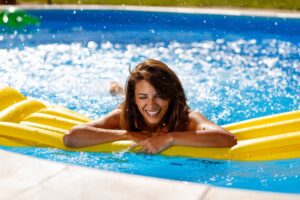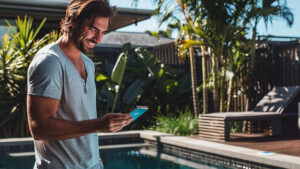Keeping a pool clean and comfortable is a technical business. However, pool owners shouldn’t feel worried or intimidated by all the jargon. Here are some common swimming pool terms you should know, what they mean and why they are important.
pH
This is the first thing that needs management in a pool! pH indicates how acid or alkaline the water is. pH 7 is neutral. A low pH is acidic, a high pH is alkaline.
The main problem with pH is that it affects the efficiency of the chlorine sanitizer. For chlorine pools, pH needs to be maintained between 7.2 and 7.6 to avoid. In addition, a low pH can cause metal or concrete etching, and stinging eyes. A high pH can cause mineral deposits, poor sanitation and algae growth. Pools, other than fibreglass, normally drift upwards to a pH between 8 and 8.5 and need regular treatment with pool (hydrochloric) acid to reduce the pH. Pooled Advanced Water Chemistry (AWC) works at the pool’s natural pH, so acid is usually not required in the vast majority of pools.
Oxidiser or Sanitiser
Algae and bacteria are controlled by sanitizers to keep your pool clean and safe. Sanitizers are powerful oxidizing agents such as chlorine (bleach), which is used in some 99% of outdoor pools, bromine, which is used in most indoor and stand-alone spa pools and some oxygen based compounds. Pooled pools use bromine as a chlorine enhancer is a mixed chlorine/bromine pool.
Sanitizer levels should be monitored daily. This is usually done with chemical test kits. The Pooled system includes sensors that monitor and control sanitizer levels in the pool
Pool Acid
Concentrated hydrochloric acid is used to adjust pH. It is dangerous and must be handled carefully and stored safely. Most pools using Pooled’s AWC don’t require the use of this powerful acid.
Buffer
Buffer is sodium bicarbonate, commonly known as baking soda. It prevents large swings in pH when acid is added to a pool. It also maintains carbonate levels, which helps look after the pool surface. Buffer levels are measured as “Alkalinity” in chemical test kits. Adding acid destroys buffer, so it needs continued monitoring and replenishment.
Pooled Advanced Water Chemistry (AWC) is designed to operate at very low alkalinity, and without the use of acid, so buffer is unnecessary.
Stabiliser
Chlorine is rapidly destroyed by sunlight. A stabilizer – cyanuric acid – protects chlorine against sunlight. Some of the chlorine combines with the cyanuric acid to form a compound resistant to sunlight, and is released later as sunlight destroys the free chlorine. However, stabilizer reduces the effectiveness of chlorine and too much stabilizer will ‘lock-up’ the chlorine and turn pools green.
Stabilizer is not required in Pooled pools.
Algaecide
Algaecides are toxic compounds used to kill algae. There are two common types – copper algaecides and organic algaecides. These both have drawbacks. Copper algaecides interfere with chemical sensors that are used to control sanitizer levels. Organic algaecides can form irritant compounds that cause stinging eyes.
AWC pools do not require algaecide and their use is not recommended.
Turbidity, clarifiers and flocculants
Turbidity refers to the optical clarity of the water. Turbid (cloudy) water is caused by light scattering from fine particles of suspended matter. Clarifiers and flocculants are chemicals that cause suspended matter to clump together and settle to the bottom of the pool, leaving the water clear.
The mineral mix used in Pooled pools is inherently flocculating, and our pools have truly striking, optical clarity.
Salt
Electronic chlorinators make chlorine from salt, but there is more than one kind of salt! Common salt is sodium chloride, but pools sometimes also use “mineral salts” which are mainly magnesium chloride. Either kind of salt can be used, though magnesium or mineral salts have a number of advantages over common salt: they feel nicer to swim in, leave hair less tangly, and suppress the formation of limescale. Even when using regular salt, Pooled adds a small amount of magnesium salt to confer these benefits.
We recommend the use of a premium brand of common and mineral salts. Cheaper forms can contain impurities such as iron or manganese that can result in stains on the pool surface.
ORP
ORP stands for Oxidation Reduction Potential. This is a tiny electrical signal that oxidizers like chlorine create in the pool water which can be picked up by an electronic sensor. Chlorinator control systems use the ORP signal to measure and control sanitizer levels.
Free and Total Chlorine
Chlorine can react with some organic compounds to produce ‘combined chlorine’. This combined chlorine can show up on chlorine tests, but it is not effective as a disinfectant, and can be very irritating. Total chlorine is the sum of the free chlorine and combined chlorine.
Unlike chlorine, bromine does not form these irritating compounds. This is why you will not find a ‘Combined Bromine’ or ‘Total Bromine’ measurement in a chemical test strip or test kit. And it is part of the reason for the very high bather comfort in Pooled pools.
Calcium Lifter
Hard water has high calcium content. In pools, an appropriately high hardness helps maintain the concrete structure of the pool, and hardness is kept high by addition of calcium chloride.
Pooled Advanced Water Chemistry is designed to operate at much lower hardness than conventional pools. In fact, the natural hardness of tap water provides sufficient calcium to maintain the pool surface in our water chemistry, so calcium additives are not required.
Comfort Zone
Comfort zone refers to the range of water compositions that are comfortable to swim in. Many factors affect this, but the most important are probably salt and sanitizer levels, pH, and the presence of irritant compounds.
The salinity of the eyes and mucous membranes is around 9000 ppm. It helps comfort levels if water is a similar salinity. Many people find salt water pools, at around 4000-6000 ppm, more comfortable than fresh water. Sea water has a salinity of 35,000 ppm. For a salt pool, check the salt limits on the heater and robot, as these both have upper limits and set the salt level appropriate to that and the requirements of your chlorinator.
Sanitizer levels around 1-3 ppm of chlorine or equivalent are generally comfortable to swim in. Higher chlorine levels become unpleasant. Even at the lower chlorine levels water can be irritating, but this is usually due to irritant combined chlorine compounds rather than chlorine itself.
pH in the range 7.5 – 8.6 is comfortable to swim in. The higher pH range is not available to chlorine pools, which require low pH for sanitation. Our experience with our customers is that they prefer the water quality in the higher pH range of our pools.
Advanced Water Chemistry is Pooled’s chemical management system based on bromine sanitation and high pH operation, which is designed to eliminate the need for acid, buffer, calcium and stabilizer, to allow for management over the internet. It uses very small quantities of chemicals, requiring only about one to two shoe-boxes of chemicals a year for typical pool sizes, which we ship when sensors indicate they are required.
Sodium and magnesium salts are added by the customer when sensors indicate low levels. AWC is compatible with all salt, mineral and liquid chlorine pools.



